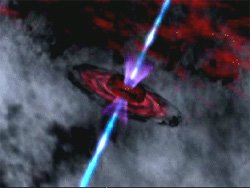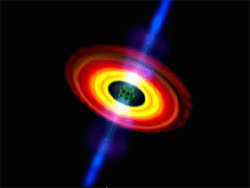Closer to the Edge

Click to view animation
(2.6 Mb -- no audio).
Credit: NASA/GSFC
Supermassive black holes are a prime target for Suzaku. These are voids in the center of most galaxies containing the mass of millions to billions of suns, all confined within a region about the size of our solar system. The black hole itself emits no light, but the process of accreting matter causes the entire region to be extremely bright in all wavelengths. Close to the edge of a black hole, X-rays are the dominant wavelength. Suzaku is sensitive to the X-ray energies emitted close to supermassive black holes, such as quasars.
The observations include clocking the speed of a black hole's spin rate and measuring the angle at which matter pours into the void, as well as evidence for a wall of X-ray light pulled back and flattened by gravity.
The findings rely on a special feature in the light emitted close to the black hole, called the "broad iron K line,” once doubted by some scientists because of poor resolution in earlier observations, now unambiguously revealed as a true measure of a black hole's crushing gravitational force. This technique can be exploited in future X-ray missions
_______________________________________________________

Click to view animation
(3.6 Mb -- no audio).
Credit: NASA/GSFC
Zoom into the center of a spiral galaxy to reveal a black hole. Cutaway of accretion disks reveals inside of the black hole. The chaotic black hole activity is hard to discern. >From our perspective, all activity is enshrouded in dust and gas in a region that's only a pinpoint a few light-years across in the center of a galaxy hundreds of thousands of light-years across, all typically hundreds of millions of light-years from Earth. The Suzaku satellite is sensitive to key X-ray energies that enable scientists to discern properties of the black hole. Some X-rays are emitted at the edge of the black hole; others are reflected off of dust clouds several light-years away. Suzaku provides the most complete picture of this black hole activity, and when combined with optical and radio observations, even more can be learned
_______________________________________________________

Click to view animation
(2.5 Mb -- no audio).
Credit: NASA/GSFC
Shown here is the tale of two hot blobs of matter moving around a black hole. Scientists can trace the movement through spectral analysis. The broad iron K line is the signature of hot iron plasma in the presence of strong gravity. In the absence of gravity, hot iron will produce a clean spike on a spectrograph at 6.4 kiloelectron volts. Because a black hole's gravity will tug at light itself, this iron line, when emitted near a black hole, is stretched, or broadened. The result is something that resembles the outline of a mountain range instead of a single spike. And yet the spectral signature gets even more complicated: As matter moves around a black hole, moving away and then closer to us, the spectral line undergoes a Doppler shift. The X-rays increase in energy when emitted from mater moving towards us (called a blue-shift) and decrease in energy when moving away from us (called a red-shift).
_______________________________________________________

Click to view animation
(4.3 Mb -- no audio).
Credit: NASA/GSFC
Scientists can discern whether a black hole is spinning or not by studying the matter and energy around the black hole. If the black hole is spinning, matter can orbit more tightly. This is called the "innermost stable circular orbit," the closest you can get to a black hole without falling in. The faster the black hole spins, the tighter the orbit. Because gravity is stronger closer to the black hole, light is stretched more. So a spinning black hole has a spectrum that's "broader" --- a reflection of iron gas that usually emits X-rays at 6.4 kiloelectron volts but instead is broadened or stretched to lower energies. How low and how broad is a reflection of how fast the black hole is spinning and how close matter gets to it.
NASA news 5th Oct 2006 Scientists Nudge Closer to the Edge of a Black Hole
______________________________________________________
Spooky Nebula from Astronomy PIC OF THE DAY
Finiteness of supergravity theories by Lubos Motl
______________________________________________________
______________________________________________________
Famous Quotes
Knowledge comes, but wisdom lingers. Alfred Lord Tennyson
______________________________________________________


<< Home